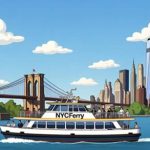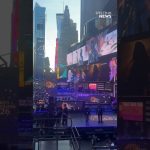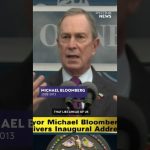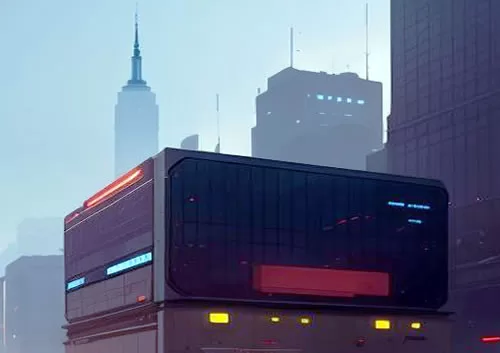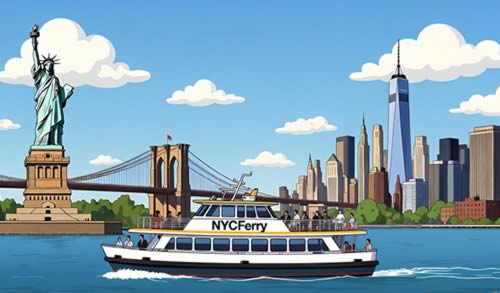Mayor Eric Adams hosts the “Hear From the Mayor” radio show on 107.5 WBLS every second Sunday. He discusses the success of community-based hiring events organized by the Department of Citywide Administrative Services (DCAS) and interviews a commissioner and a newly employed individual. They highlight the effectiveness of these events in providing job opportunities and connecting with communities. Additionally, Mayor Adams addresses a caller’s concern about transit patrol engagement in the subway system, emphasizing the importance of officers being actively involved in patrolling platforms and cars.
Gary Byrd: You know what happens each and every Sunday of the month, the second Sunday, WBLS is proud to welcome the 110th mayor of New York City, the second mayor of color, and the first hip hop mayor in the city’s history. It’s time to hear from the mayor, Mayor Eric L. Adams on 107.5 WBLS. Mr. Mayor, good morning, and welcome.
Mayor Eric Adams: Hey, brother, it’s good to be back with you. I heard my brother Fatiyn in the studio earlier also. We go back like car seats, man.
Byrd: Yes, man.
Mayor Adams: We’ve been doing this for so long.
Byrd: Tell the truth.
Mayor Adams: To the listeners, welcome back to another episode of Hear from The Mayor. I’m your mayor, Eric Adams. If this is your first time tuning in, the purpose of this show is just really to hear from you, and just engage in some dialogue. Listeners should give me a call, and hear directly from your mayor on what we are doing to build a better city. You can sign up to hear more from me by visiting nyc.gov/hearfromeric.
You can sign up on our website to Text with Eric, talk with me on WhatsApp, and listen to my “Get Stuff Done” podcast, but today you can call in (212) 545-1075, (212) 545-1075. You know what? Ask a question. We want to get as many callers as possible, so I know sometimes we want to get all of our thoughts out, but just try to keep it succinct, so we can get as many people as possible.
Really excited about today. I’m here with one of my favorite commissioners, Commissioner Dawn Pinnock over at DCAS. A lot of people don’t even know about DCAS, but it is an agency that encompasses so much in our city government, and everything from our purchases of vehicle, to our personnel, it’s a huge responsibility, and this sister has just really given us all the comfort of knowing that this city can run smoothly with her there.
She’s not traveling alone. Her back is being covered by her sister, Michelle, who’s also here in Gracie, hanging out with us. They look so much alike, but really, Dawn, good to see you. You have been just a real power in our government, and we want to thank you for what you’re doing. You are here also with sister Jayda Rodriguez. Jayda is a Bronxite. Went off to college at Duke University, and she is part of the successful hiring halls that we have.
We want to really hear from both of them. I want to start with you, Dawn. If you could just give an overview of what our new jobs opportunities is about, and what we’re doing, and just a snippet of what you do over at DCAS.
Commissioner Dawn Pinnock, Department of Citywide Administrative Services: Good morning, and thank you, sir. First of all, DCAS, it’s a pretty long name. It’s the Department of Citywide Administrative Services, but similar to what you said, many folks are unclear about what we do. We are the service provider to all city agencies reporting to the mayor. Whether it’s citywide procurement, citywide equity and inclusion, human capital, energy management, fleet, we provide services to all city agencies to ensure that they meet their missions.
Our mission is to make New York City government work for all New Yorkers, and we do that by serving every agency reporting to you, Mr. Mayor. In terms of what we’re doing around hiring, it’s really wonderful to be here with Jayda, and I look forward to hearing her story, because really, through Jayda and the thousands of employees that are now working within New York City, we’re showing that community-based hiring works.
About hiring halls, you know this full well, Mr. Mayor, because you were at every event with us. We kicked this off last year, and we had weekly events where we went to every corner of the city, bringing jobs, not just entry-level jobs, security jobs, procurement jobs, energy jobs, to all corners of the city, and we made 2,200 job offers, and to sit here today to know that Jayda, in addition to about 70 percent of those folks who received those same day job offers work within New York City, it shows that our model works, it’s effective, and it’s efficient.
Mayor Adams: What’s interesting here, as I bring on Jayda, think about it for a moment, if you were to go to the average New Yorker and say, “How do you get a job? How do you apply for a job? Where do you go to be hired?” The average New Yorker won’t have a clue, and we take it, those of us who are working, we take it to believe that, “Okay, just pick up the one ad page,” or just think, “Fill out your resume.”
We saw in our hiring halls, as the commissioner stated, we knew we had to go down to interact one-on-one with the people. These hiring halls were amazing. We were seeing anywhere from 800 to a 1,000 people come in, and we walked them through the process in a very orderly and very friendly way, to take them from unemployment to employment. Something is wrong when you have 14,000 available jobs, but you have a high unemployment in the city, and particularly, in Black and brown communities. We have to connect the dots. A lot of people are intimidated by walking into a governmental agency. We say, “Let’s go to community centers, let’s go to schools. Let’s go to college campuses. Let’s go to NYCHA residents’ community facilities,” to make people know that we’re going to come to you, not have you tried to find us. One of those success stories is really Jayda, who’s here today. Jayda, why don’t you just give us an overview of how you came about to be employed at DCAS, and your journey?
Jayda Rodriguez: Thank you, Mayor Adams. Happy to be here this morning. Post-pandemic, I was looking to jump back into the workforce. As you mentioned, it’s unclear how to find jobs quickly. I was really fortunate that a friend mentioned that their agency, DCAS, has been having these community hiring events with different roles connected to renewable energy, where I’ve built my experience. I jumped on the opportunity, and actually attended the hiring hall the same day that I found out about it, and I’m incredibly grateful that I did.
Mayor Adams: What was interesting, Jayda, we, Dawn built this overnight. It was a series that I will go to train stations, hand out fliers, we will go to our pastors, our clergy leaders, and have them talk about it from their pulpit, from their synagogues, their churches, their mosques, and we just had a whole frontal assault. I was blown away, the number of the lines that we had.
If you have someone like Jayda, who is well-credentialed from the Bronx Science, which is a great school in the Bronx, and then going to Duke, if you are struggling to find a pathway to employment, imagine what an average kid like me, with my public school CUNY graduation, or those who don’t have any college degree, or English is a second language.
We knew we had to find a friendlier way to do it. When you were at the hiring hall, what went through your mind, and what would you encourage other people who are out there right now looking for employment on what they should do as they move forward?
Rodriguez: I would say, to put yourself out there. I found out about the hiring hall, found a suit in my closet, and got my resume printed, and was there within three hours of hearing about it. Within an hour of arriving, I was interviewing with three employees at DCAS, who are doing great work, and gave me a sense of what the agency is up to, and how I could contribute.
Within a couple of days, I was sitting for a second interview, and had been onboarded in under six weeks. I think just getting out of the house, and getting in front of people to your point, and connecting face-to-face will help you achieve your goals.
Mayor Adams: Talk about that, Dawn, what was, when you created the hiring halls and the actual operationalizing of it, what went through your mind of, “Okay, how do we do this to make people feel comfortable,” and then have a setting where people are not just walking away feeling they don’t have a chance?
Commissioner Pinnock: We really wanted to focus on an all of government approach. As you mentioned, it was a full-frontal assault. We wanted to, first of all, understand the data, be clear about those jobs where we had potentially highest risk, using social media as a communication medium, having folks distribute flyers at train stations. The goal was really to meet New Yorkers where they were.
Whether they were in a community center, a senior center, if there was a call that we could place, because you had actually started to call folks to a robocall, finding out where people were, and finding out what their interest was. Every step of the way, we continued to build upon the model. We started off where we would have folks, who would serve as wayfinders.
You would come in, you would have a chance to see a floor map. We created a barcoding system, so you can download job descriptions, know what agencies were there, salaries. We created an information table to walk people through the experience, so that every step of the way, they knew that there was someone there who worked at an agency that wanted to support them in being gainfully employed.
Mayor Adams: Hats off to Henry Garrido, the leader of DC 37. He planted the seed when I was on the campaign trail, and we actualized it, and operationalized it. What I liked about it, if you saw hiring hall 1, it was totally different by the time we got to hiring hall 8, 9, 10, 11. You constantly went in with your team. You had an amazing team. They went in, and they said, “Okay, how do we build a better mousetrap?”
Each hiring hall, you added something new. The first hiring hall, people were outside in the cold weather. You said, “No, we got to do something different.” The wayfinders – You just constantly evolved until it just became a hiring hall in the box, used to call it, of how we implemented that. Your team was amazing. What went into that?
Commissioner Pinnock: Thank you. Certainly, your support was instrumental. In addition to learning, we were trying to build this plane, as we were flying it. We knew the kind of experience that we wanted to create for New Yorkers. We also drew upon our experiences when we first started in city government. It was unprecedented for us to go beyond our desks, and work in a community center, or in another building, really, to bring a face to government, which is what we wanted to do.
As you mentioned, each step of the way, we continue to build upon the model, and we’ve actually put together a playbook. It went from hiring hall in the box to an actual playbook, where we talk about what you should do from a communications perspective, what you should do around charting your success with your vacancies, how you get your vacancies approved. We have a playbook that now feeds into the enhanced model that we’re now seeing with Jobs NYC.
Mayor Adams: You know what was fascinating, that every day you go there, your people were enthusiastic. Far too often, governmental employees are really removed from the people that they see. When you saw the excitement when you used to ring the bell, or when people got hired, or another offer, People were engaged, and people just enjoyed that they were helping their fellow New Yorkers, and they no longer saw each other as numbers, they saw them as individuals.
Jayda was no longer just a stat, this was a person who said, “Listen, I had to take time off from Covid to help my family members, and now I want to get back into the workforce.” Jayda, as you move through, did you see yourself, “Now I’m at DCAS,” you’re in a pretty prestigious place what you’re doing right now. What is your everyday job environment for you?
Rodriguez: Well, I work at the Division of Energy Management within the Clean Energy and Innovation Unit, and we test out different technologies and different approaches to renewable energy to help decarbonize our city’s operations, and make the city greener.
Mayor Adams: People often don’t realize the fullness of government. When I went into the police department, I was a computer programmer. People thought that, “Okay, you’re going to the police department, you’re only going to chase bad guys.” Not realizing that there are people who are in aviation, there are people who are in the harbor unit, there are people who are in our school division. There’s just so much you can do in city government.
People didn’t even realize that, if you want to look at how you improve the environment, there’s a place for you in city government. There’s not one passion you have that is not in city government. If you want to be a mechanic, there’s a job for you in city government. If you want to deal with children, there’s a job for you in helping children.
Those who are out there listening, you should realize, whatever your passion is, there’s a place in public service to actually live out that passion. I think what you said about, just get out your house. We’ve gotten so used to being inside, and feeling, “Woe is me.” What you said is, “Why not me? I’m going to charter my own course.” Having you here today encourages those people who are sitting on the sideline, and trying to figure out what they can do with their lives. Give them the next step of what they can do.
Rodriguez: I would say, connect with people in your industry, and talk about what options they might be aware of. My network helped me to find this job. I would also say that, sometimes applying for a job that you’re not sure you’re qualified for can open up doors for you. I’ve seen people at the agency pass resumes along to people in other divisions, because an applicant might be a better fit for what another program is doing. Just getting in front of a human being can allow them to help you find the right fit for you.
Mayor Adams: Love it. I hear the music in the background. Really happy to have you here. Good luck to you. Trust me, you’re going to be commissioner one day. I could just tell. So great having you here, Dawn. We’re going to chat. You transition to some higher orders, but wish you the best.
Commissioner Pinnock: Thank you so much.
Rodriguez: Thank you, Mayor Adams.
Byrd: (212) 545-1075 is the number to call. You’ve heard from the mayor, and now the mayor wants to hear from you, especially, I’m sure about the hiring halls that the city is doing. (212) 545-1075, Mayor Eric Adams. Hear from the mayor, and talk to him right after this from 107.5 WBLS.
Hey whats up, Gary Byrd on your radio with Mayor Eric Adams. It’s Hear from The Mayor, and the mayor wants to hear from you, (212) 545-1075. Now, here he is, the mayor of our city, Mayor Eric Adams.
Mayor Adams: Hey, brother. Great beginning interview. We want to get people working. We want to get people employed. Our job is more than what we do in the a.m. hour of our day. It’s a precursor to sleep that allows you to experience the American Dream, and we want to engage folks. Let’s open the airwaves, (212) 545-1075. Can we go to our first caller?
Byrd: Good morning, caller. You’re in the air. Go right ahead, please. First name, and where you’re calling us from.
Question: Good morning, Gary Byrd. Good morning, Mayor Adams. This is Ivette calling from Queens. How is everyone?
Mayor Adams: Quite well. Good morning.
Question: Good morning. I just want to, first of all, thank you for the first part of the speech from the commissioner, and the young lady who is employed. Congratulations to both.
Mayor Adams: Thank you.
Question: I have a question about transit. I often ride the subways, and I guess I remember transit of yesteryears, where the officers actually patrolled the cars and patrolled the platforms. Too often when I see them, they’re against the wall talking, or if there’s four, they’re together, as opposed to two on one side, two on the other. What can we do to get them more engaged with the subway platforms, and the cars?
Mayor Adams: Love it. You are not speaking to the choir, I wrote the song. You are so right. We had a major shift in transit patrol after Wenjian Liu and Officer Ramos were assassinated in Brooklyn. We went from single patrol to dual patrol. Just the whole concept that we had officers no longer being engaged in, under previous administrations, they were not dealing with fare-beaters, not dealing with just some of those quality of life issues.
We are back engaged, it’s just going to take… It took a little time to have people focus back on what you’re saying, walking through the trains’ cars, walking up and down the platform. As a former transit cop, I knew what patrol looked like, and now we are getting our officers back engaged. You’re seeing a lot of quality of life enforcement, not just summonsing because we don’t want to criminalize people, but getting them engaged in correcting conditions.
All those encampments we saw in our system, they’re no longer there. We are just getting back to that good patrol, and I’m so happy you said this, because so many people who come from an extreme view of saying that there should be no police officers in our subway system. That is just wrong. Every time I’m on the system, people say we want to see our uniform officers, we want them to move around, we want them to engage, we want to feel safe in our subway system. I thank you for that.
Crime is down in our subway system. We started out with a rocky January, but we saw a [24] percent decrease in March. 15 percent decrease in – I’m sorry, February, [24] percent in March. We’re moving in the right direction. You are so right. I’m going to take what you just said, and I’m going to play it in all my precincts in transit districts, because people want to see their police officers.
Byrd: You’re in the air with Mayor Eric Adams, Hear from The Mayor, and the mayor wants to hear from you. First name, and where you’re calling us from, right here at WBLS. Good morning.
Question: Good morning. I’m Joanne from Plainfield, New Jersey. I’m just so very, very proud of the way Mayor Adams handles situations, particularly, considering the daily obstacles that are placed before him. I’m just so very, very proud of Mayor Adams. Thank you very much.
Mayor Adams: I really appreciate that. People think words are what comes to our ears, but it’s more than that. It’s what inspires our soul. Mommy used to always say to me, “Baby, you got this.” I learned from previous mayors, I saw what they did to first Black Mayor David Dinkins, how they turned the Black community against him. How they constantly had him under attack.
You go look at some of those old articles and you say, “Wait a minute, this is déjà vu.” They beat him down, although the city was recovering under him, and what did we inherit? We came after him, after they were a constant onslaught, and so, as I was saying to you, Gary, earlier, when I hear the extremists criticize and attack what we have done in this city, I look at the success, more private sector jobs in the history of this city recovered.
Those independent financial experts have stated that, “This mayor has managed the city well.” We overcome Covid. 180,000 migrant and asylum seekers without any real federal help. We were able to recover 40 percent increase in crime when we came in. Now, we’ve seen a double decrease in shooters and homicides. We’ve placed more people in homeless shelters into permanent housing in the history of this city in a year.
More people in vouchers for homeless, we placed in housing in the history of the program. We go on and on of what we have done. It has been lost in the noise. I’m saying to New Yorkers, don’t allow the haters to get in the way of the accomplishments of this mayor and this administration. The most diverse administration in the history of this city, and we got a lot more we want to do, but it’s only been two years and three months.
Byrd: Yes. Eric, as we keep our eye on the clock as well, I want people to make sure that they understand, this is one of several platforms, as you indicated towards the top of the broadcast that you have for people to make that connection. Before we sign out, could you let people know exactly how they can actually connect with you on the other platforms you have available as well?
Mayor Adams: Yes. So true. We have several different platforms. The most important platform is the ability to get to jobs. That is what is extremely important to us, but for those out there, you can also get us at, sign up to hear more by visiting nyc.gov/hearfromeric. You can find out more that we’re doing, and it’s just stay in touch, and really, also go to jobs.nyc.gov. We want to get folks employed.
Once a month, I’m on this airway to continue to let you know what we’re doing in the city. I look forward to the continuation of moving our city forward with New Yorkers. Greatest city on the globe, only two types of Americas: Those who live in New York, and those who wish they could, we’re the lucky ones.
Byrd: I love Duke Ellington. Duke Ellington was asked, he said, they said, ‘Well, what about other cities outside of New York?’” Duke said, “After New York, there are no cities.”
Eric, thanks so much as always, my brother.
Mayor Adams: Thank you, brother.
Byrd: Stay strong. All right.
April 14, 2024 Manhattan NY
Source: NYC.gov – Midtown Tribune News
Big New York news BigNY.com


